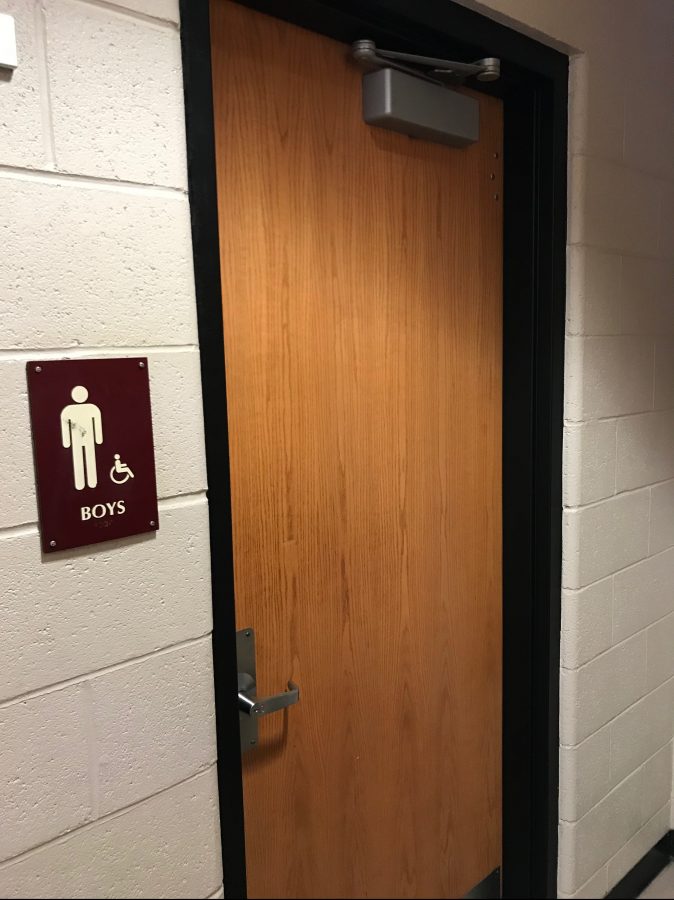Bathroom Break: An Urgent Problem
November 17, 2017
Almost every day, at least one Radnor High School boys’ bathroom is locked. Sometimes it’s one, sometimes it’s two and sometimes it’s three. Yet, virtually no one knows why a specific bathroom is locked at any given time. The general student body certainly doesn’t know. The teachers don’t know either. Surprisingly, even the administrators don’t know why specific bathrooms are locked. Despite the best of intentions, Radnor High School is suffering from a series of challenges that are made worse by communication failures. We need to work together to solve this urgent problem.
The prevailing student theory is that the Administration locks the bathrooms to prevent the vapers from vaping. Some point to the fact that the boys’ bathroom near the International Café, a well-known vaping hotspot, is locked nearly every week as proof for the “vaping” theory. Appealing as it is, that conclusion turns out to be false. According to Principal Bechtold, “Vaping is an issue, but we are not locking down bathrooms for vaping.” So, why then are bathrooms being locked?
With the vaping myth debunked, the other common theory is one of collective punishment. Maybe the Administration, after hearing about students engaging in senseless vandalism such as breaking soap dispensers, flooding bathroom floors, intentionally clogging toilets and ripping urinal dividers off the wall, decided to punish the student body as a group. By locking bathrooms, they would send a message to stop. Once again, that theory does not hold up. According to Principal Bechtold, bathrooms are not being locked as a punishment. In fact, he neither locks them himself, nor does he order that specific bathrooms be shuttered. Mr. Bechtold does receive briefings about the bathrooms (and the rest of the building) as part of the weekly Thursday operations meetings, but he does not run around locking bathrooms.
So why are bathrooms locked and what is the process to lock one? Apparently, the primary reason a particular bathroom gets locked is safety. Mr. Bechtold said, “We take student safety seriously here and we want to get them back up and running as soon as possible. … If there is a safety hazard, we don’t want students in there because they can slip and fall.” And he “couldn’t imagine being a custodian and having to go in and clean up after a student clogs the toilet. … That’s crazy and not fair to our custodial staff.”
Based on this information, the reasons for locking the bathrooms appear legitimate and clear. However, the process for actually locking bathrooms remains murky. There are two possible ways that a bathroom gets locked. First, a student tells a teacher about a safety hazard and the teacher locks the bathroom. Second, a custodian notices a hazard and locks it down to clean/repair it.
That process is missing one big phase: communication. When a bathroom is locked, there is no sign on the door warning would-be users or explaining why and for how long it will be out-of-service. Most obviously, the simple addition of a sign would redirect people more quickly to other locations. More problematically, this failure to communicate leaves bathrooms locked for more time than they need to be. For example, if a bathroom was locked because the floor was wet and needed to dry, nobody knows when to unlock the door because no one knows how long the floor has been drying.
The school needs to have a sign on the door that has three things. First, the sign should indicate the time the bathroom was locked. Second, the sign should state the estimated time the bathroom will be unlocked. While this is only an estimate, it will help people understand the magnitude of the problem. Third, the sign should state who locked it and why. This last piece is crucial. It adds accountability, allows for tracking, and may even provide a bit of deterrence. Knowing who locked the bathroom and why will help to squelch unfounded rumors that the Administration is running amok. This information will also allow the Administration to create a private database of the shutdowns that it might be able to use in crafting a plan going forward on how to curb the shutdowns. Finally, if students understand that the actions of a few, destructive classmates are impacting wide swaths of our community, they may no longer look the other way. Ultimately, these signs and the data they reflect will help the Administration make an informed decision, which is important because how we deal with this reflects our values as a school.
As students, there are three paths that we can take. One option is to ignore the problem. In theory, it would be easy for teachers and female students at RHS to shrug their shoulders and move on because it does not affect them directly. That is not the Radnor way. Another option is to force the male identifying students (or perhaps all students in the interest of equal treatment) to sign in before going to the bathroom, just like the Middle School does, to deter bad behavior and to help identify the culprits. This should not be the Radnor way. It would punish large – and innocent – portions of student body as a collective. The third option resists rash action and can reflect our values. As a community, we could have an inclusive dialogue on why this is happening and on how to stop it.
I am an optimist. I believe that our Administration will choose the third option. Posting the signs described above would be a good first step, but we can and should go farther. Unlike the bathrooms, Mr. Bechtold’s door is unlocked and always open. He and our new Superintendent Mr. Batchelor, both former social studies teachers, believe in students’ rights. Remarkably, both men in separate interviews uttered essentially the same sentence, “Maybe I/we need to be more communicative with the student body.” Unprompted, they also expressed interest in the unruly students’ motives. Mr. Batchelor said that he wants to ask the bathroom wreckers, “Why are you doing this? What’s going on? … Is there something [you] are rebelling against?” Their background, in conjunction with their ability to admit that we have a problem, gives me hope. I hope they follow through.







